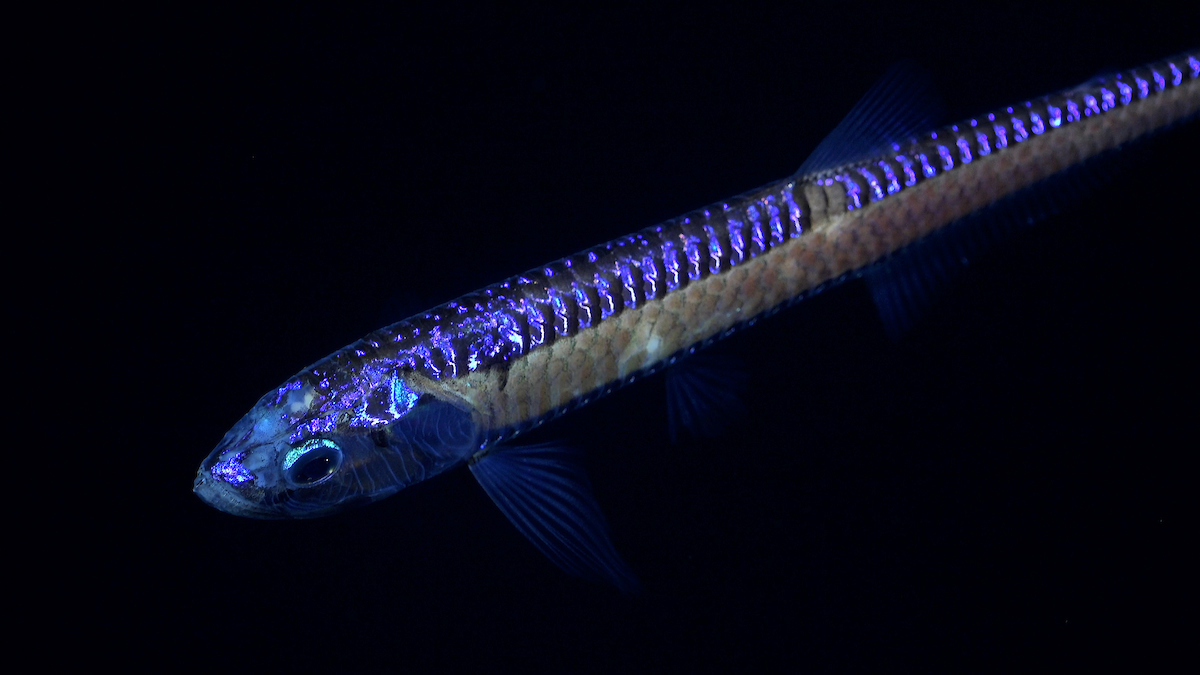Dozens of new species have been discovered along the Salas y Gómez Ridge off the coast of Rapa Nui, also known as Easter Island, the remote Pacific island famous for its giant stone moai human statues. Among the never-before-seen critters found here were squid, fish, corals, mollusks, sea stars, glass sponges, sea urchins, crabs, and squat lobsters.
They were discovered during a recent expedition by the Schmidt Ocean Institute’s R/V Falkor (too), which is currently surveying the underwater environment within the Pacific Ocean deep off Chile’s coastline.
At the Salas y Gómez Ridge, part of a chain of 110 volcanic seamounts, the team identified 160 different species, at least 50 of which are thought to be new to science.
A deep-sea dragon fish, an apex predator with enormous jaws filled with fang-like teeth, found on the southeastern flank of an unexplored and unnamed seamount.
Image credit: ROV SuBastian / Schmidt Ocean Institute
They also stumbled across the deepest-known photosynthesis-dependent animal in the world: Leptoseris, also known as the wrinkle coral.
“The observation of distinct ecosystems on individual seamounts highlights the importance of protecting the entire ridge, not just a few seamounts,” Dr Erin E Easton, Chief Scientist at Schmidt and Assistant Professor at the University of Texas Rio Grande Valley, said in a statement.
“We hope the data collected from this expedition will help establish new marine protected areas, including on the high seas on the Salas y Gómez Ridge,” said Easton.
A Chrysogorgia coral and squat lobster found on the northern flank of Motu Motiro Hiva, an uninhabited island along the Salas y Gómez Ridge.
Image credit: ROV SuBastian / Schmidt Ocean Institute
Along with tracking down living creatures, the expedition carried out a hydrographic survey of the seabed’s geographical features. A total of 78,000 square kilometers (30,116 square miles) of seafloor were mapped, including six seamounts that hadn’t yet been documented.
A seamount is an underwater mountain with steep sides that are typically the remnants of extinct volcanoes. In the wide open ocean, they serve as hives of biodiversity, providing surfaces for deep-sea corals, sponges, fish, cephalopods, and crustaceans.
An octopus seen on the southeastern flank of an unexplored and unnamed seamount located within the national jurisdiction of Chile, east of Motu Motiro Hiva, an uninhabited island along the Salas y Gómez Ridge.
Image credit: ROV SuBastian / Schmidt Ocean Institute
The seamounts, such as those found in the Salas y Gómez Ridge, also serve as a vital “pit stop” that supports the migration of marine creatures such as whales, sea turtles, swordfish, tuna, and sharks.
This is the second expedition to Salas y Gómez Ridge by the Schmidt Ocean Institute this year. Back in February 2024, their first trip to the area revealed 100 new species, including corals, glass sponges, sea urchins, amphipods, and lobsters.
The researchers described the ecosystems of this region as “pristine” – and now they have the evidence to showcase its unique biodiversity, they’re hoping the region can get the protection it needs to keep it that way.
“The astonishing habitats and animal communities that we have unveiled during these two expeditions constitute a dramatic example of how little we know about this remote area,” explained Dr Javier Sellanes of the Universidad Católica del Norte.
“These expeditions will help alert decision-makers about the ecological importance of the areas and contribute to strengthening protection strategies within and beyond jurisdictional waters,” continued Dr Sellanes.
Source Link: Over 50 Unknown Species Found In "Pristine" Marine Ecosystems Near Rapa Nui
